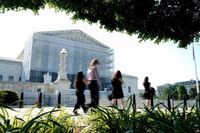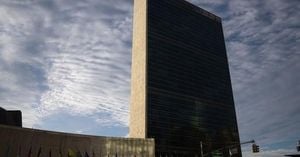In the wake of the 2022 Supreme Court decision in Dobbs v Jackson Women’s Health Organization, the landscape of reproductive health in the United States has undergone seismic shifts. New research is now shedding light on some of the unexpected consequences of these changes, particularly for infants born with life-threatening congenital heart defects. Meanwhile, a parallel debate is intensifying in courtrooms across the country, where religious liberty claims are becoming a central strategy in legal challenges to abortion bans.
According to a recent study published in Pediatrics, rates of cyanotic congenital heart disease (CCHD)—a severe form of congenital heart defect—have risen in states that enacted abortion restrictions following the Dobbs ruling. For context, congenital heart disease is the most common congenital birth defect in the United States, affecting roughly 1% of all births. CCHD, in particular, is a dire diagnosis: cyanosis, or a bluish discoloration due to lack of oxygen, often appears in the neonatal period, and the mortality rate within the first year of life is a sobering 25%.
The study, which analyzed birth data from the CDC’s Natality Information and Live Births databases between 2016 and June 2024, set out to compare outcomes before and after the Dobbs decision. In total, researchers examined 31,637,533 live births, identifying 19,413 cases of CCHD. The findings were striking: in states with restrictive abortion policies, there were 8,279 cases of CCHD out of 12,918,010 live births. In contrast, protective states—those that maintained or expanded abortion access—reported 4,226 cases among 9,051,257 live births.
What’s more, the difference in CCHD incidence between restrictive and protective states has grown over time, particularly since Dobbs. The study reported a higher median monthly incidence of CCHD both nationwide and specifically in restrictive states in the post-Dobbs period. The gap between restrictive and protective states widened, with four out of 24 months after Dobbs surpassing the upper bound of the 95% prediction interval for CCHD rates. This suggests that the increases are not just statistical noise, but represent a real and significant trend.
States like Texas, which have implemented some of the strictest abortion laws in the nation, have also seen higher rates of infant mortality, a trend that aligns with the new findings. As the study’s investigators wrote, "Prenatal diagnosis of CCHD provides the opportunity for counseling of the specific anomaly… [but] the ability to terminate the pregnancy for significant CCHD could be limited by varying state policies after Dobbs." This limitation, they argue, is contributing to the rising rates of CCHD births in states with more restrictive abortion laws.
The researchers didn’t stop at raw numbers. They also sought to estimate what CCHD rates might have looked like if Dobbs had never happened. By calculating 95% prediction intervals based on pre-Dobbs trends, they found that the actual incidence of CCHD in restrictive states was significantly greater than expected in most months following the decision. A related study presented at the American College of Cardiology’s Annual Scientific Session put a finer point on the disparity, reporting a difference of 9.6 infants with CCHD per 100,000 births between restrictive and protective states.
These findings raise pressing questions about the broader impact of abortion policy on public health. Investigators concluded, "This changing epidemiologic landscape of CCHD may have implications on long-term health care system infrastructure." As more infants are born with complex medical needs in states with limited abortion access, hospitals and pediatric cardiology units may face increasing strain.
But the story doesn’t end with medical statistics. The legal and cultural battles over abortion have taken on new dimensions in the aftermath of Dobbs, with religious liberty claims now playing a starring role in challenges to abortion bans. As reported by Law360, religious freedom arguments are gaining traction in courtrooms across the country, with plaintiffs asserting that abortion restrictions infringe on their sincerely held religious beliefs.
It’s not just abortion that’s at issue. The U.S. Supreme Court, according to Law360, has shown a remarkable appetite for religious freedom cases in recent years, tackling everything from prayers at football games to insurance coverage for contraception. This broader legal context has emboldened advocates on both sides of the abortion debate to frame their arguments in terms of religious liberty.
As of August 12, 2025, religious liberty claims are increasingly being used in legal challenges against abortion bans. While the Law360 article doesn’t provide specific case details, it paints a picture of a legal landscape in flux, with the Supreme Court’s interest in religious freedom cases setting the stage for potentially landmark decisions.
For abortion rights advocates, religious liberty arguments offer a new avenue for contesting restrictive laws. Some religious groups contend that their faith traditions support access to abortion, and that bans violate their right to practice their beliefs. On the other side, supporters of abortion restrictions often invoke their own religious convictions as the moral foundation for such laws, creating a complex clash of values in the legal arena.
It’s a tug-of-war that reflects the broader polarization of American society on questions of reproductive rights and religious freedom. The courts are now being asked to weigh not just the constitutional right to privacy, but also the meaning and limits of the First Amendment’s protection of religious exercise. The outcome of these cases could have far-reaching implications—not just for abortion policy, but for the balance between individual rights and state power in the United States.
Meanwhile, the health care system is left to grapple with the real-world consequences of legal decisions. As the Pediatrics study makes clear, policies that restrict abortion access can have unintended effects on infant health, particularly for those born with severe and often fatal medical conditions. The growing gap in CCHD rates between restrictive and protective states is more than a statistical artifact; it’s a signal that the policy choices made in statehouses and courtrooms are reverberating in delivery rooms and neonatal intensive care units across the country.
As the legal battles rage on and the data continues to accumulate, one thing is becoming clear: the intersection of abortion policy, religious liberty, and public health is shaping up to be one of the defining issues of this era. The stories behind the numbers—of families, doctors, faith leaders, and lawmakers—will undoubtedly continue to unfold in the months and years ahead.
For now, the nation watches as its courts, legislatures, and hospitals wrestle with the consequences—intended and otherwise—of a decision that continues to reshape the American landscape.




